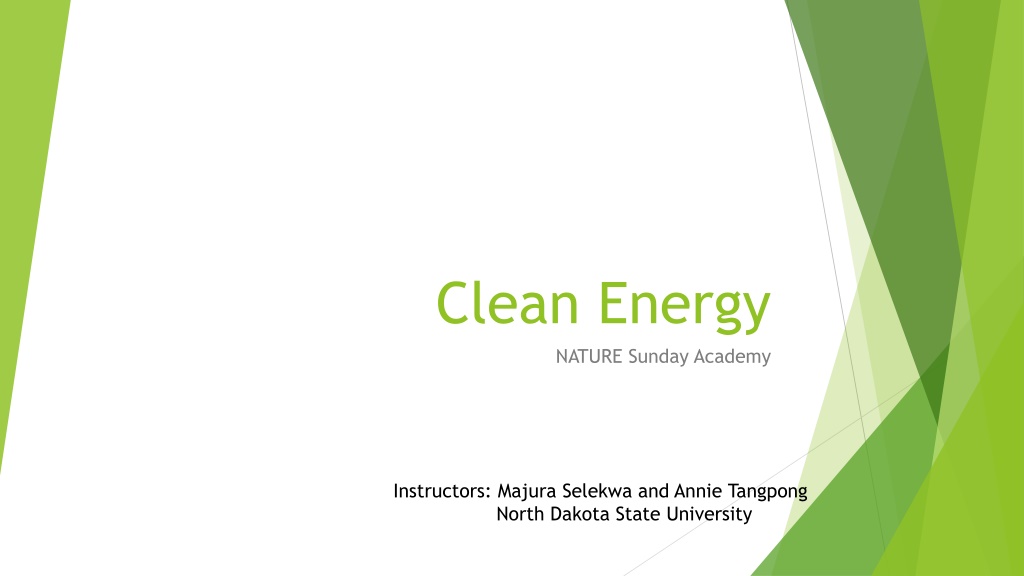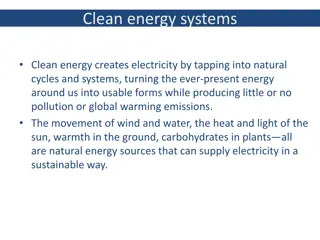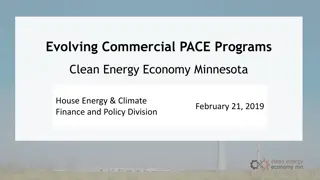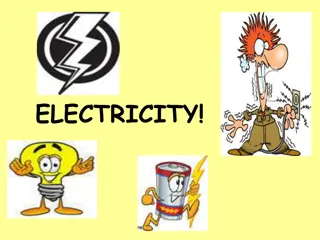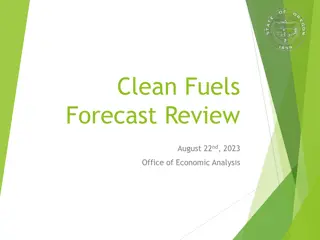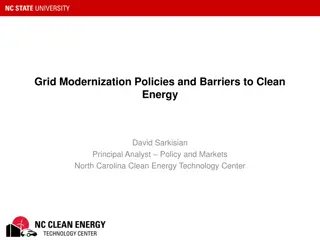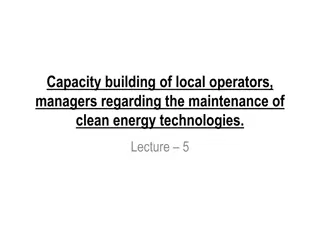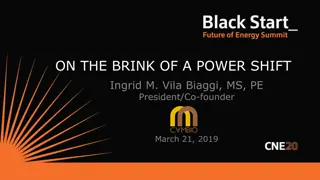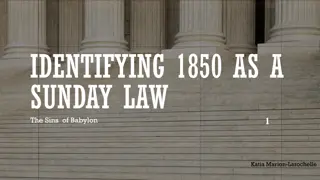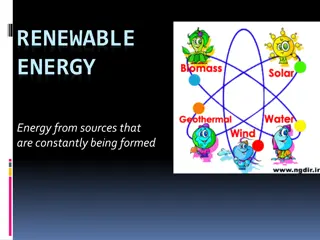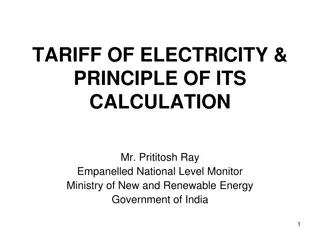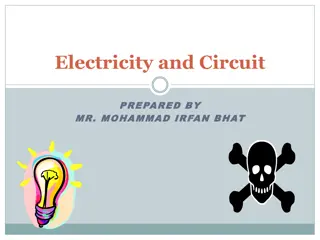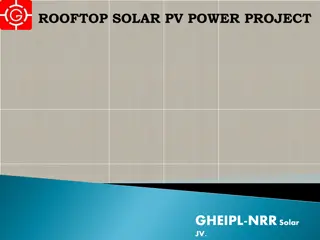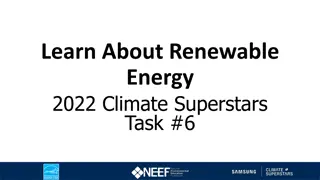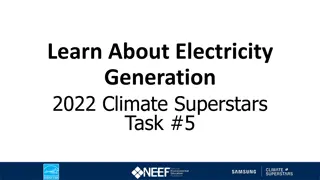Understanding Energy and Electricity in Clean Energy Nature Sunday Academy
Explore the basics of atoms, electrons, and electricity, along with the formation of molecules and the concept of energy in the universe. Discover the relationship between conductors and insulators, the common uses of energy, and how electricity powers various aspects of our lives. Join the session with instructors Majura Selekwa and Annie Tangpong from North Dakota State University to delve into clean energy concepts.
Download Presentation

Please find below an Image/Link to download the presentation.
The content on the website is provided AS IS for your information and personal use only. It may not be sold, licensed, or shared on other websites without obtaining consent from the author. Download presentation by click this link. If you encounter any issues during the download, it is possible that the publisher has removed the file from their server.
E N D
Presentation Transcript
Clean Energy NATURE Sunday Academy Instructors: Majura Selekwa and Annie Tangpong North Dakota State University
Session Outline Topic 1: Atoms, Electrons and Electricity Topic 2: Fuel Cells, Hydrogen, Water, Wind energy Topic 3: Fuel Cells With Solar Energy
Atoms and Electrons If you cut anything to the smallest part that you can no longer cut, then that smallest part will likely be an atom. Atoms are the building blocks of everything in the universe; everything you see is made of atoms. The atom is so small that 1.25 trillion atoms will be required to line up in one inch. The 118 types of atoms; the smallest atom is HYDROGEN and the largest is UNUNOCTIUM Atoms are made up of three parts Negatively Charged Electrons (-) Positively charged Protons (+) Neutrally charged Neutron Protons and electrons attract each other Protons and Neutrons are kept together in the nucleus of the atom
Atoms and Molecules The most common and abundant atoms in the world are HYDROGEN, OXYGEN and CARBON One or more atoms can pack together to form molecules: Two atoms of hydrogen form one hydrogen molecule Two atoms of hydrogen and one atom of oxygen form water One atom of carbon and two atoms of oxygen form Carbon dioxide molecule Two atoms of Carbon, four atoms of hydrogen and two atoms of oxygen from a sugar molecule. Video: https://www.youtube.com/watch?v=vlSOESXQI7o
Electricity Different molecules pack together to form different materials in the universe. Some materials have electrons that can move freely within the material, while other materials have no such free electrons. Conductors and Insulators Electricity is due to motion of electrons in the material; If connected across a charged unit, the free electrons will be attracted from the negative charge side to the positive charge. Electricity flowing through a human body can cause shock and even death by electrocution. Video: https://www.youtube.com/watch?v=ZAFW4zdXpbY
Energy Concepts Energy is one of the most fundamental parts of our universe; what are common uses of energy: heating our homes and cooking our food, lighting our homes, powering our televisions and cellphones moving parts of a machine such as in our cars and many other applications Electricity is one form of energy, can HEAT, MAKE LIGHT and cause MOTION QUESTION: If there is no electricity, how can you light and heat your house? Energy is not created by human, it already exists in nature; human can only harvest and transform it into a usable form.
Natural Energy Sources Fossil fuels: They were formed from the remains of dead prehistoric plants and animals that have been buried under earth for more than 600 million years. Examples: Petroleum oils, Coal and Natural Gas They are made of Hydrogen and Carbon atoms, also known as Hydrocarbons. Harvested by drilling, mining and fracking LIMITATIONS: No new fossil fuels are made today, so what can happen in future Depletable source NOT RENEWABLE We transform their energy content by burning them to produce heat energy LIMITATIONS: Burning petroleum and coal hydrocarbons produces HEAT, CARBON DIOXIDE, and CARBON MONOXIDE NOT CLEAN ENERGY Note that burning NATURAL GAS produces HEAT and carbon dioxide only; there is no Carbon Monoxide.
How to get motion out of fossil fuels When fossil fuels are burned in an engine motor, they cause air in the engine to expand. Such expansion makes engine parts to move and rotate. Video: https://www.youtube.com/watch?v=OGj8OneMjek
Natural Energy Sources (contd) Wind Formed by moving air. As the sun heats the land, the air above also warms and rises. Cold air from another place then replaces the rising air creating a flow we know as wind. Wind Energy is harvested by using windmills which directly transform it into motion ADVANTAGES: Clean, .GREEN Not depletable RENEWABLE LIMITATIONS: Not reliable .. Naturally moving water such as at the Niagara falls and the Hoover dam can also be harvested in a similar way.
Natural Sources of Energy (Contd) Solar Energy Is a continuously radiated by the sun; this is the most abundant energy source in the world Harvested either by directly heating fluids or by using solar panels to generate electricity Not depletable Clean .GREEN Available almost everyday except on rainy days There many other natural sources of energy, for example biomass, Geothermal energy food for muscle energy
Why Electricity? All primary sources of energy can be converted into electricity and transported through wires over long distances. Most of the conversions uses an electric generator. When the engine is connected to an electric generator, it generates electricity Wind mills can directly be connected to an electric generator to generate electricity Is Electricity a primary energy source?
Car Motors All cars have motors that make wheels rotate and drive the car. Most cars use motors that run on gasoline as energy source or fuel; such motors are also known as gasoline engines DISCUSSION: Knowing that gasoline is a fossil fuel, what limitations do we face in using these cars? Do you know hybrid cars?
Car Motors (contd) Hybrid cars uses a combination of gasoline motors and electric motors powered by batteries DISCUSSION: What are advantages of hybrid cars? Knowing that the electrical part of hybrid cars runs on a battery, what are the possible limitations?
Fuel Cells Fuel cells use hydrogen to produce electricity, which can be used to drive electrical cars. Hydrogen atoms enter a fuel cell at the catalyst anode where they are stripped of their electrons, i.e., ionizes them. The positively ionized hydrogen atoms pass through a proton exchange membrane leaving the electrons to pass through an external wire, which provides the current electricity. The electron, ionized hydrogen, and oxygen meet at the cathode catalyst where they form water http://americanhistory.si.edu/fuelcells/images/fc_ani.gif
Challenge in using Fuel Cells The challenge in using fuel cells is how to make Hydrogen. Unlike the sun where there is plenty of free Hydrogen, the earth has no free Hydrogen; it only appears combined with other elements. Most of the Hydrogen on earth appears combined with Oxygen as Water. Another significant amount of Hydrogen appears combined with Carbon as Hydrocarbons. Ethanol, Methane, Fossil fuels With plenty of water on earth - over 71% of earth is water - we can get the desired hydrogen from water !
Electrolysis of Water Fuel cells can also be reversed to break water into hydrogen and oxygen. By applying current electricity across the fuel cell immersed in water, it would cause water to beak into hydrogen and oxygen The process of breaking water into Hydrogen and Oxygen by using current electricity is known as electrolysis. Lysis = dissolve or break apart Electro-lysis= break by electricity Your Hydrogen pump has a fuel cell that breaks the water into Hydrogen by electrolysis. Oxygen is just thrown out because it is easily available in air.
How Electrolysis Works At the negative end (Cathode): Water receives excess electrons from the battery, which causes it to form atoms Hydrogen and negatively charged ions of another compound known Hydroxide (one atom of Hydrogen and one atom of Oxygen) At the positive end (Anode): Water loses electrons, forming Oxygen atoms and positively charged Hydrogen ions. The negatively charged Hydroxide ions and the positively charged Hydrogen ions combine again to form water, leaving Hydrogen at the Cathode and Oxygen at the Anode. Since pure water does not conduct electricity well, electrolysis of water is normally achieved by adding salt to improve electrical conductivity in water.
Activity 1: Open a Fuel Cell and See what is inside. Open the provided fuel cell units and identify the following parts Catalyst Anode 1. Proton Exchange Membrane 2. Catalyst Cathode 3.
Activity 2: Test the performance of the Fuel Cell Car Follow instructions on a separate handout to fill hydrogen into your car. Drive your car and find out the following information: How long it takes to drain its hydrogen tank. How far the car can go before it runs out of fuel. How fast the car can run.
Solar Energy Solar Energy continuously radiated by the sun; this is the most abundant energy source in the world The sun is the largest object in the solar system About 75% of the sun is made of hydrogen, which burns continuously generating heat at a temperature of over 2.8 million Fahrenheit The burning fire radiates light and heat from the sun to all over the solar system. Imagine that the sun as huge fire pit Solar energy means all of what is radiated by the sun due to its burning fire
The Sun Radiation The radiation from the sun has several components as: Infra-Red: This is the heat that makes us feel comfortable and can cause sun burns Visible Light: This is the light that makes us see things during the daylight. It has seven components: Red light, Orange light, Yellow, light Green light, Blue light, Indigo light, Violet light Ultra violet: Part of this radiation is used by our bodies to make Vitamin D, which is required for the body to absorb calcium and build strong bones. However there is some part of this radiation that can cause skin cancer! X-rays and Gamma-rays also are present but very insignificant The useful solar energy is due to infra red and visible light only: why?
Harvesting Solar Energy Infra-red radiation energy can be harvested by: focusing sunlight from a wide area into a small area using materials that retain heat for a long time
Harvesting Solar Energy (contd) Visible light energy is harvested by using light sensitive materials that are made to generate electricity. The process is known as photovoltaic effect: photo=light, voltaic= creation of electricity Devices for generating electricity due to light are known as Photocells, or Photovoltaic Cells, or Solar Cells Each Solar Cell generates only 0.5 volts Several such Solar Cells can be packed together to form a Solar Panel; .Why Several Cells?
How Solar Cells Work Solar cells are made of four layers of material: The front layer, which is what you normally see, is covered by a front contact grid The inner layer 1 The inner layer 2 The back layer The front layer accepts light and prevents it from being reflected back Inner layers are made of special material known as semiconductors: L1 attracts electrons towards light while L2 repels protons away from light. If an external circuit is connected between them, then electrons flow from L1 towards L2 and form current electricity
Activity 3 1. Use convergent lens to harvest infra red radiation 2. Measure the voltage from solar panel 3. Use a solar panel to drive the Fuel Cell X7 car 4. Use a solar panel to create hydrogen for use in Hydrogen car
Review Electrons, atoms, molecules What is an electron? What is the difference between an atom and a molecule? Electricity What is current electricity? List three things that electricity can do. Different sources of energy, concepts of renewable and clean energy Name three major sources of energy, Why some sources are known as renewable while others are not? Which sources are not renewable and which ones are renewable? Why some sources are known as clean while others are not clean? Which sources are not clean and which ones are clean? Methods of harvesting and transforming energy How do we harvest fossil fuel and how to transform it into usable form? How do we harvest wind and how do we transform it into usable form? How do we harvest solar energy and how do we transform it into usable form?
Review How different sources of energy can be converted into electricity How is fossil fuel energy converted into electricity? How is wind energy converted into electricity? How is solar energy converted into electricity? Motors for current cars and hydrogen cars of the future What future limitations do we face in using gasoline motors in cars? What is the main purpose of introducing hybrid cars? What is a fuel cell? How do fuel cells work?
Review Origins of Solar energy Where does the solar energy come from, and how? What is the sun mainly made of, and how is it used to generate solar energy? Components of Solar energy Solar energy has two major components, what are these components? What is infra-red? What is visible light? How many components are there in visible light? What are they? Methods of harvesting Solar Energy How many methods are there for harvesting infra-red energy? Explain the first method Explain the second method Solar panels are for harvesting what component of solar energy? What is a solar cell, how does it differ from a solar panel Explain the structure of a solar cell
